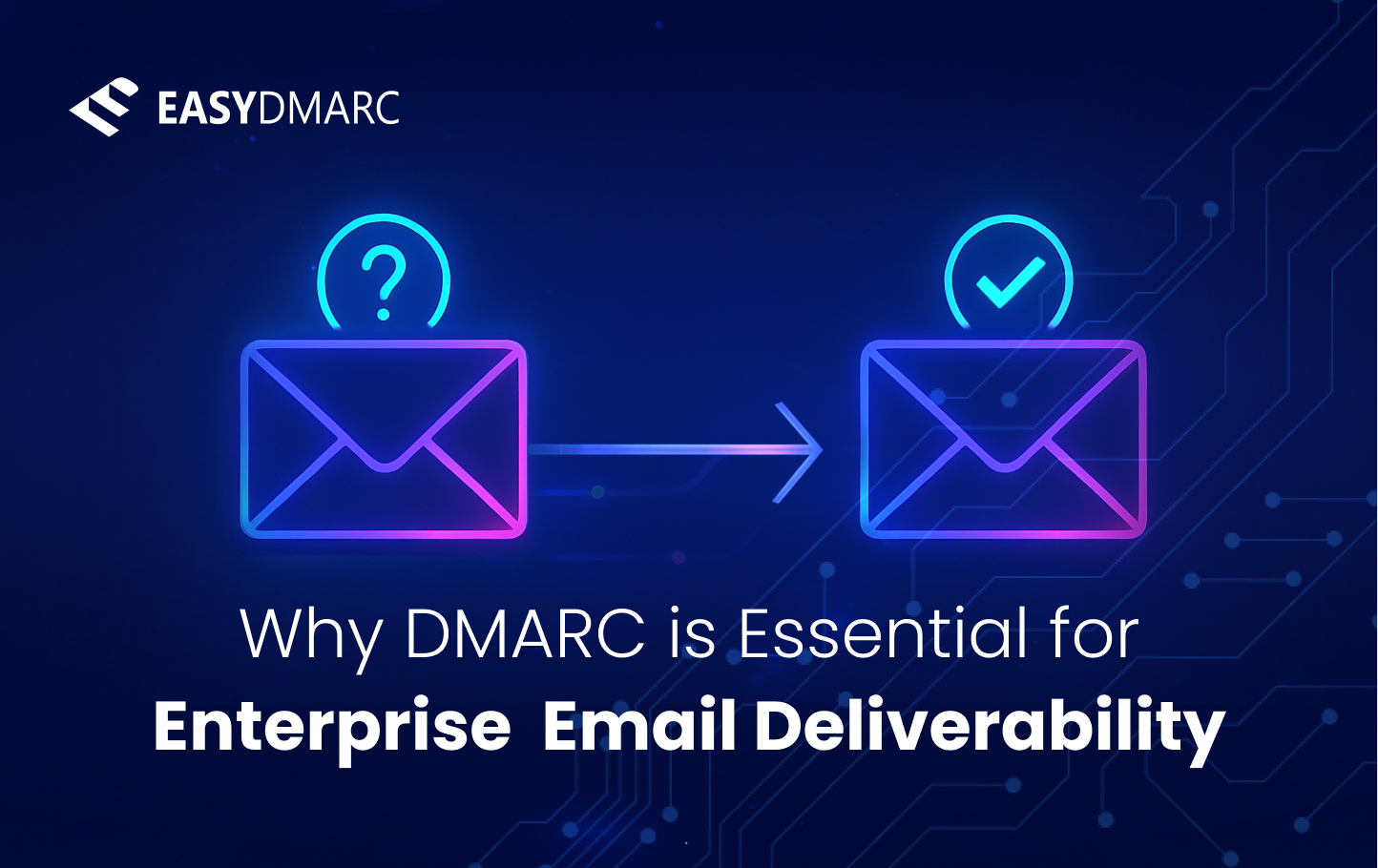Email has always been one of the easiest ways for businesses to reach their customers, but in 2025 the expectations are much higher. It’s no longer enough just to send an email. You have to prove it’s really coming from you. Phishing and spoofing attacks, where hackers pretend to be trusted brands, have made people more careful about opening emails. At the same time, inbox providers like Google and Yahoo have started paying closer attention to who is sending messages and whether they can be trusted.
This is why DMARC email deliverability has become so important. DMARC is a system that helps email providers confirm your messages are genuine. For businesses, this means fewer emails landing in spam folders and more trust from customers. Basically, today enterprise email deliverability depends on having strong authentication, and DMARC is at the center of that.
Email Deliverability in 2025
So what’s changed in 2025? The biggest shift is that inbox providers are no longer leaving email security up to the sender. They now require bulk senders to use DMARC along with other authentication tools. If a company doesn’t meet these rules, its emails are far more likely to get filtered into spam or even blocked completely. To avoid this, businesses that aren’t sure if they meet these new standards can quickly review their domain status using a DMARC Checker to spot gaps before deliverability is affected.
This change comes at a time when phishing attempts are increasing. Hackers often target brands that don’t have proper protection, using their names to trick people into clicking harmful links. That’s why email providers now check email trust and sender reputation, aside from looking at the content of a message. With such a strict regulatory system in action, securing your business email not only means stopping attacks, but also makes sure that your messages actually reach your customers’ inboxes.

DMARC and Its Role in Email Authentication
How does DMARC actually work?
DMARC (Domain-based Message Authentication, Reporting, and Conformance) is an email security standard that helps providers verify that emails really come from the domain they claim to. Setting it up begins with creating a proper DMARC record, which can be done in minutes with a DMARC record generator, to avoid formatting mistakes that could cause authentication failures. A DMARC doesn’t work alone, but builds on two other authentication tools:
- SPF (Sender Policy Framework): Confirms that emails are sent from servers approved by your domain.
- DKIM (DomainKeys Identified Mail): Adds a digital signature to emails, proving they haven’t been changed on the way to the recipient.
DMARC combines these two systems and checks if they’re properly aligned, meaning the domain in the email’s “From” address matches the one authorized in SPF and DKIM. This alignment is key because it makes it much harder for attackers to send fake emails using your brand’s name.
But DMARC’s purpose isn’t merely blocking bad emails. It also improves email deliverability. When providers see that your emails are authenticated and consistent, they’re more likely to deliver them to the inbox instead of spam. This leads to fewer bounces, a better sender reputation, and often higher engagement from customers who can trust your messages.
The Cost of Not Adopting DMARC in 2025
But what happens if a company doesn’t use DMARC? The truth is, the risks are bigger than most people think.
First, there’s the obvious one: poor email deliverability. Without DMARC, providers see your messages as less trustworthy. That means more of your emails will bounce back or end up in spam folders, where customers are unlikely to ever see them. If your business relies on email to communicate with clients, promote products, or share important updates, this can quickly become a serious problem.
Then there’s the bigger danger: phishing and impersonation attacks. If your domain isn’t protected, hackers can pretend to be you. They might send fake invoices, trick customers into giving out sensitive information, or spread harmful links — all under your name. Besides hurting the people who receive them, these attacks also damage your brand’s reputation. Customers lose trust, and once that trust is gone, it’s incredibly hard to earn back.
The costs of dealing with such an incident can be tough. Companies often face financial losses from fraud, the expense of fixing their email systems, and even legal or compliance issues if they work in sectors like finance or healthcare, where data protection is strictly regulated.
To reduce these risks, many organizations turn to experienced DMARC vendors for enterprises who can help them strengthen authentication and protect their domain reputation.
How EasyDMARC Helps Enterprises Achieve Full DMARC Compliance
The good news is that getting started with DMARC doesn’t require much of your time or effort, especially when you choose a system with a user-friendly interface and simple implementation, like EasyDMARC.
For many businesses, the hardest part of adopting DMARC is knowing where to begin. You need to create a proper DMARC record, make sure your SPF and DKIM settings are correct, and then monitor how different email services are using your domain. EasyDMARC make this entire process easy for you.
With EasyDMARC, you can:
- Quickly analyze your SPF and DKIM records to spot and fix issues before they impact deliverability.
- Monitor DMARC reports through dashboards that turn complicated data into simple insights, so you can see exactly who is sending emails on your behalf.
- Visualize your enforcement readiness, know when it’s safe to move from monitoring to stronger DMARC policies like quarantine or reject.
- Avoid common misconfigurations that often lead to email delivery problems.
For enterprises managing multiple domains, EasyDMARC also offers automated workflows and optional managed services to make the process smoother. This way, you can strengthen your email security and improve deliverability without disrupting day‑to‑day communication.
DMARC Enforcement Is Now a Competitive Advantage
DMARC changes how email providers and recipients see your brand. When you implement stricter policies like quarantine or reject, inboxes view your domain as more secure and reliable. This sends a trust signal, which directly impacts where your emails land. Messages from authenticated domains make it to the primary inbox, instead of being filtered into promotions or spam folders.
This trust also leads to a stronger sender reputation. Reputation is like a score that inbox providers assign to your domain based on how safe, consistent, and reliable your emails are. A higher score means better inbox placement and fewer delivery issues. Over time, this can greatly improve your email performance metrics. You’ll see higher open rates, more clicks, and even better engagement levels as recipients grow to recognize your emails as legitimate and safe.
For enterprises, this improvement creates real opportunities: marketing emails reach more customers, transactional messages (like invoices or password resets) get delivered faster, and internal communications stay reliable across teams and partners. Companies that fully implement DMARC stand out in their customers’ inboxes and gain a competitive edge over those still relying on outdated or weaker authentication practices.
How to Enforce DMARC: The Gradual Approach
Learning how to setup dmarc and switching to a strong policy doesn’t happen overnight. It’s a process, and taking it step by step helps you protect your emails without accidentally blocking messages you still need.
1. Start with monitoring (p=none): The first step is creating a DMARC record with the policy set to p=none. This doesn’t block any emails. Instead, it lets you collect reports showing which servers are sending emails on behalf of your domain. These reports help you see if all your legitimate email sources (like your CRM, marketing platform, or third‑party tools) are properly set up.
2. Review and clean up: Next, look closely at the reports. You’ll often find emails being sent by tools you forgot about, like an old newsletter service or a system still using your domain. This is the time to make sure every sender you use is authenticated with SPF and DKIM.
3. Move to quarantine: Once you’re confident that most of your senders are properly set up, you can update your DMARC policy to p=quarantine. This tells email providers to filter suspicious emails into a spam folder instead of delivering them normally.
4. Move to reject: Finally, when you’re sure only legitimate senders are using your domain, you can set the policy to p=reject. This blocks any unauthorized emails entirely, keeping phishing attempts from reaching inboxes.
5. Watch out for common roadblocks: Many companies struggle with third‑party tools (like marketing platforms or payroll systems) that don’t support proper authentication. Others run into issues with inconsistent DNS records or simply lack visibility into who’s sending on their behalf.
Using tools like EasyDMARC’s dashboards can make these challenges much easier to handle by showing you exactly what needs fixing before you tighten your policy.

Deliverability Is Security, and Security Is Deliverability
In 2025, DMARC has become a business‑critical function for enterprises. Email providers now evaluate authentication when deciding whether to deliver messages. Strong DMARC policies improve inbox placement, build sender trust, and reduce the risk of phishing or spoofing attacks.
Why Enterprises Need DMARC
- Improved inbox placement: Authenticated domains achieve higher deliverability rates.
- Stronger brand trust: Verified messages help customers feel confident engaging with your emails.
- Protection against impersonation: Blocks unauthorized senders from using your domain.
- Regulatory readiness: Reduces compliance risks in sectors with strict data protection rules.
How EasyDMARC Helps
- Guided setup tools for creating and managing DMARC records.
- SPF/DKIM analysis to resolve configuration issues.
- Visual dashboards for tracking reports and understanding enforcement readiness.
- Enterprise‑scale solutions including multi‑domain management and automated workflows.
DMARC is now central to enterprise email deliverability strategies. Adopting and managing it effectively guarantees secure, reliable communication and secures your company’s reputation and operations.
Frequently Asked Questions
EasyDMARC helps businesses implement and enforce DMARC policies through an intuitive platform and innovative tools like EasySPF that simplifies the email authentication process. It provides visibility into your SPF, DKIM, and DMARC configurations, identifies misaligned sources, and offers actionable insights from DMARC reports. With EasyDMARC, enterprises can move confidently toward full enforcement, reduce spoofing risk, and improve inbox placement without disrupting legitimate email traffic.
Major email providers like Google and Yahoo now require DMARC for bulk senders. Without a proper policy in place, enterprise emails are much more likely to be flagged as spam or rejected entirely.
No. SPF and DKIM provide authentication, but without DMARC, there’s no way to enforce policies or monitor misuse. DMARC is necessary to align authentication and block spoofed messages.
Without DMARC, your domain is more vulnerable to phishing attacks and spoofing. In 2025, you also risk deliverability issues as inbox providers increasingly enforce stricter authentication requirements.
It depends on your email infrastructure, but many enterprises follow a phased approach: start with monitoring (p=none), identify all sending sources, and gradually move to full enforcement (p=reject) within a few weeks to months.


